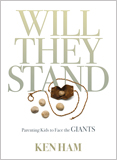Seeing Jesus in the Everyday
When we look, we can see Jesus even in the ordinary moments of our lives.
My husband and I have a flock of about a dozen chickens in a backyard coop. Our boys enjoy taking care of them and collecting the eggs. But as anyone who keeps chickens knows, along with the benefits of fresh eggs come inevitable predators. You name it, we’ve had it invade our coop and range area (no matter how secure we try to make them): a racoon, opossum, mink, hawk, and even a stray husky.
As we clean up the carnage, we discuss what happened. And we do it in a way that helps the boys connect the Bible’s teachings to the world they encounter. When sad things like this happen, it’s easy to brush it off as the natural order of things. But that’s not entirely true, is it?
In the midst of cleaning up chicken feathers, we talk about how God’s world was originally very good. Coons and chickens got along with each other. Dogs and ducks were friends. And the menu for all the animals was fruits and veggies—not each other. But then we stress that sin changed all that—Adam’s sin and our sin in Adam.
We now live in a world that groans under the curse imposed on it by the Creator because of our disobedience. As our boys grieve the loss of our chickens, we let them feel a bit of that weight, recognizing the agony that sin—and its punishment, death—has brought to this world. But we go on to remind them of the hope that we have through that same Creator who came to be our Savior. We tell them that all who receive his gift of eternal life have the promise that one day the curse will be no more and we will again live in a world filled with harmony and friendliness among all creatures in the very presence of our Creator.
It’s vital that even in these small spheres of life we show our kids that Jesus and his Word go beyond a few hours at church.
While that might seem a weighty message to share over chickens, it’s vital that even in these small spheres of life we show our kids that Jesus and his Word go beyond a few hours at church—they are present in our daily lives. I’ve known far too many people unable to explain the bad things in this world because they don’t understand the truth of God’s Word. As a result, they eventually turn their back on their Creator entirely.
As we teach our boys about life, we try to implement what Answers in Genesis calls the Seven C’s of History, significant past events that have dramatically affected—and continue to affect—our world. We use this biblical framework to connect our Creator and his Word to our everyday lives.
In Nature
When we walk down our lane and enjoy the pretty flowers and the variety of trees lining the road, we point out how God created them to provide shade and oxygen. We look out for beautiful yet harmful thistles and discuss the dangers of poison ivy. And when one of the boys brings me a rose from the garden, he shows me the prick on his finger from the thorns. We again return to Genesis, which reminds us that God created all plants for our sustenance—except that one tree—and that, with one disobedient choice, the plants were also placed under the curse of sin. We talk about the crown of thorns placed on our Savior’s head, reminding us of the salvation Jesus accomplished on our behalf. And then we look into the future when there will be no more thorns or thistles, just as it was in the beginning.
In the spring, we begin planting seeds for our garden, always hopeful that this will be the year we reap its full rewards. We remind ourselves that God created fruits and veggies “after their kind,” so when we put a tomato seed in the dirt, we can expect to harvest tomatoes, not a watermelon or a blueberry (Genesis 1:11). As we deal with the effects of pests and diseases and drought, we look back at Genesis 3 to understand why working the ground is so difficult, even in our small plot.
We often explore the little creek that runs through our property. Even though we are in an area far from the ocean, we uncover loads of rocks filled with fossils of various sea creatures. Those fossils launch conversations about the catastrophic flood of Noah’s day that laid down so much mud, covering all types of creatures, which we find today as fossils. We wonder at the details preserved in these fossils that show this wasn’t a process that happened over millions of years, but a catastrophe that happened quickly in the relatively recent past. We remember that as Noah was saved on the ark from the great flood—God’s punishment that brought justice on sin—we are saved from our sin through repentance and faith in Jesus, the only way to God.
We marvel at the intricately designed honeybees living in the hives on our property. We delight in the features of the praying mantises that show up in our garden. We gaze in awe at the stars and planets we spot in the night sky. We scratch our heads at the fascinating bagworm cocoons hanging from our mailbox and flowers. No matter where we look—from the minuscule to the macroscopic—we see the fingerprints of an all-good Creator and give him glory for what he’s made, even as we continue to live under the curse.
In Entertainment
As the boys have grown, we’ve paused cartoons and movies to discuss the false ideas they present (such as evolution, millions of years, and wrong theology). We then teach the truth from God’s Word, grounding the boys in the reality that the Bible informs all areas of our lives. For example, the Disney show Miles from Tomorrowland as well as the Star Wars films and The Mandalorian feature travel through outer space where characters encounter a variety of alien life-forms. We talk about how Jesus created intelligent life on earth, and how Adam’s sin affected the entire universe (including any supposed aliens). We point out that since Jesus came to die for mankind—not for aliens—extraterrestrial intelligent life most likely doesn’t exist.
With any movie about dinosaurs, such as The Land Before Time or Jurassic Park, we counter the false ideas about when dinosaurs lived and continually remind them that God created dinosaurs on day six of creation week—the same day he created the first two people. When we encounter the idea that dinosaurs evolved into birds, we point out that because God created birds a day earlier than dinosaurs on day five, they are separate creations that reproduce after their own kinds.
In Education
As part of partnering with others in the boys’ education, we examine their textbooks, drawing attention to the evolutionary and anti-God ideas, encouraging them to evaluate the false statements and showing them the biblical and scientific truth, such as the formation of rocks, fossils, and humans. In a lesson about animal groups, a textbook asked, “Did you know you are a mammal, too?” We talked about how humans share some similarities with animals—we breathe the same air, eat the same types of food, and have similar features—but that we are not just mammals. God fearfully and wonderfully created humans in his image to display his glory.
As they study the history of our nation and when we visit a Native American site, such as the Badlands in South Dakota, we remind them that the original settlers in these areas walked across land bridges or sailed the seas after dispersing from Babel about 4,200 years ago. As descendants of Noah—and even further back, Adam and Eve—these people groups are our relatives, part of the same human race.
We reinforce this truth when we talk about world events happening in Iran, North Korea, Russia, or Nigeria. People in other parts of the world are all part of our family, all made in the image of God, and all in need of the same Savior, Jesus Christ.
From the time our children were born, we’ve made sure to focus on Jesus in our conversations. Through catechism, informal conversations, and devotions, we point them to the Bible’s teachings about all things pertaining to life and godliness and encourage them to know their Creator intimately, seeing him in the everyday moments of their lives.
Seven C’s of History

The Seven C’s
of History provide
a framework to
help us connect
the Creator and
his Word to our
everyday lives.
From left to right: Creation, Corruption, Catastrophe, Confusion, Christ, Cross, Consummation
Answers Magazine
January–March 2021
Meet the team of artists and writers behind the world’s most pro-life museum exhibit.
Browse Issue SubscribeRecommended Resources

Answers in Genesis is an apologetics ministry, dedicated to helping Christians defend their faith and proclaim the good news of Jesus Christ.
- Customer Service 800.778.3390
- © 2024 Answers in Genesis







